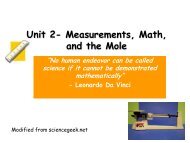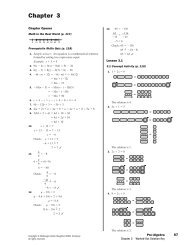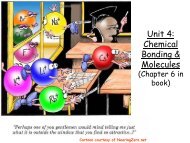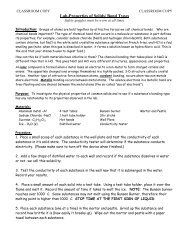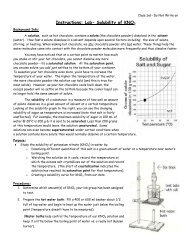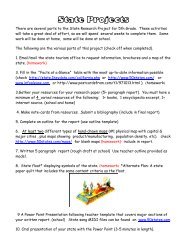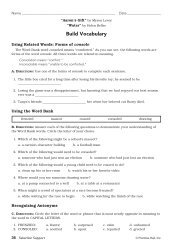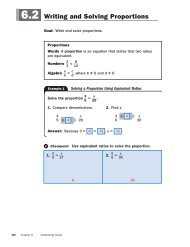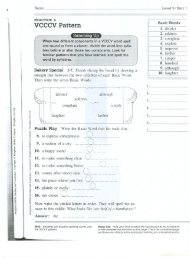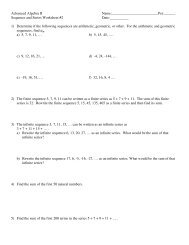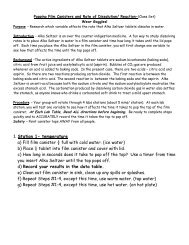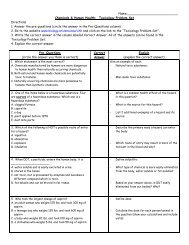Unit 5 â Solutions, Acids & Bases
Unit 5 â Solutions, Acids & Bases
Unit 5 â Solutions, Acids & Bases
Create successful ePaper yourself
Turn your PDF publications into a flip-book with our unique Google optimized e-Paper software.
Essential Skills Review
5-1. Know the definitions of solute and solvent (CSS: 6a)<br />
5-2. Know how to describe the dissolving process at the<br />
molecular level using the concept of random molecular<br />
motion & how temperature, pressure and surface area<br />
affect the dissolving process. (CSS: 6b, 6c)<br />
5-3. Know that molecules in a liquid move in random<br />
patterns relative to one another because the<br />
intermolecular forces are too weak to hold the molecules<br />
in a solid form. (CSS: 2d)
Making <strong>Solutions</strong><br />
• Solution: a mixture of two or more<br />
substances in a single phase<br />
• Solute: the substance that is dissolved into<br />
the solution<br />
• Solvent: the substance that dissolves the<br />
solute<br />
• Factors that Speed Up the Dissolving<br />
Process:<br />
1. Increase in temperature<br />
2. Increase in surface area (grinding up<br />
the substance)<br />
3. Agitation (stirring or shaking)<br />
4. Increase in pressure (this only works<br />
for gases)<br />
• “Like Dissolves Like”<br />
Solute + Solvent = Solution
5-4. Know how to calculate the concentration of a solute in<br />
terms of grams per liter, molarity, parts per million and<br />
percent composition. (CSS: 6d)
Concentration Calculations<br />
• Molarity (M)<br />
• % Composition<br />
M<br />
MolesofSolute<br />
LitersofSolution<br />
GramsofSolute<br />
% Composition<br />
x100<br />
GramsofSolution<br />
• Grams per Liter (g/L)<br />
GramsperLiter<br />
GramsofSolute<br />
LitersofSolution<br />
• Parts per million (ppm)<br />
ppm<br />
• Conversion Factors to know:<br />
• 1 gram H2O = 1 mL H2O<br />
• 1 L = 1000 mL<br />
GramsofSolute 6<br />
x10<br />
GramsofSolution
5-5. Know the observable properties of acids, bases, and<br />
salt solutions; that acids are hydrogen-ion-donating and<br />
bases are hydrogen-ion-accepting substances; (CSS: 5a,<br />
5b)<br />
5-6. Know how to use the pH scale to characterize acid and<br />
base solutions. (CSS: 5d)<br />
5-7. Know that strong acids and bases fully dissociate and<br />
weak acids and bases partially dissociate. (CSS: 5c)
pH Scale<br />
• Reading a pH Scale:<br />
• 0 < 7 = acid<br />
• 7 = neutral<br />
• 7>14 = base<br />
• Strong acids are closer to<br />
pH 0<br />
• Strong bases are closer to<br />
pH 14<br />
• Weak acids & bases are<br />
closer to pH 7
Dissociation of <strong>Acids</strong> & <strong>Bases</strong><br />
Strong <strong>Acids</strong> or <strong>Bases</strong><br />
Weak <strong>Acids</strong> or <strong>Bases</strong><br />
• Almost completely<br />
dissociation in water<br />
• Only partially dissociation in<br />
water
5-8. Know how an acid and a base neutralize each other.
Neutralization<br />
• <strong>Acids</strong> and bases react to form salts (ionic<br />
compounds) and water<br />
• The products of this reaction have a pH ≈ 7 (neutral)<br />
• Acid + Base Salt + H 2 O (neutral substance)



